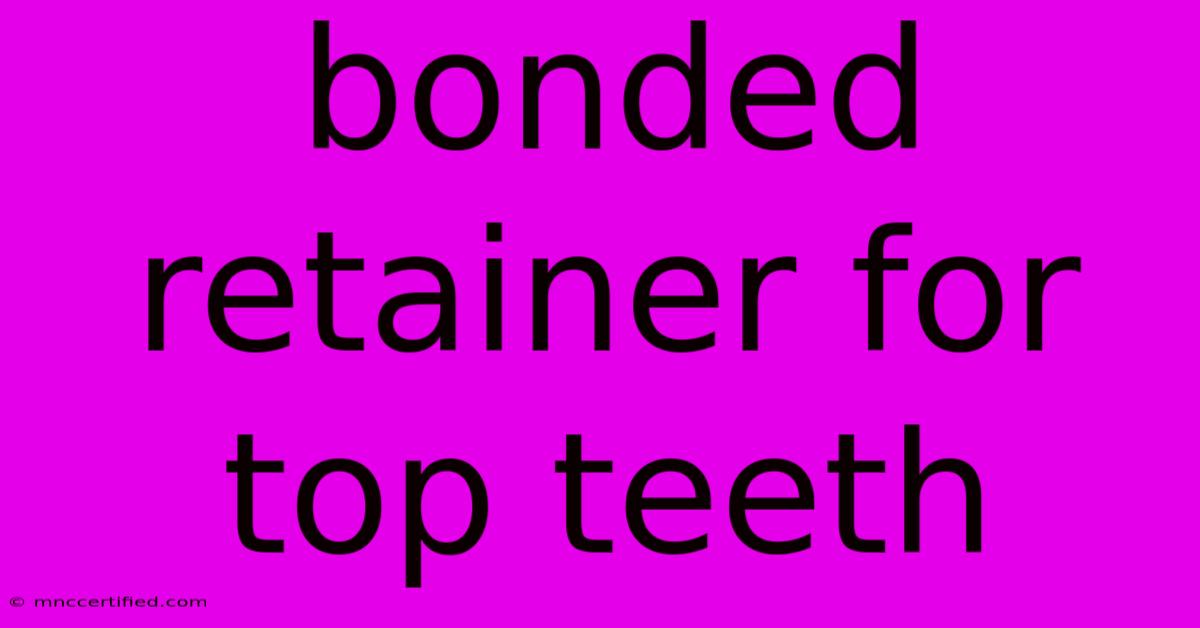Bonded Retainer For Top Teeth

Table of Contents
Bonded Retainer for Top Teeth: A Comprehensive Guide
A bonded retainer for top teeth is a popular choice for patients after orthodontic treatment, offering a discreet and effective way to maintain a straight smile. This comprehensive guide will delve into everything you need to know about bonded retainers, from their advantages and disadvantages to care and maintenance. Understanding these aspects will empower you to make an informed decision with your orthodontist.
What is a Bonded Retainer?
A bonded retainer is a thin wire that's cemented directly to the back of your upper (or sometimes lower) teeth. Unlike removable retainers, it's permanently bonded in place, providing continuous, passive retention. This means it gently prevents your teeth from shifting back to their original position. The wire is typically made of strong, durable, and biocompatible materials like stainless steel or tooth-colored materials for improved aesthetics.
Advantages of a Bonded Retainer
- Discreetness: Unlike removable retainers, bonded retainers are virtually invisible, making them a great option for those concerned about aesthetics.
- Convenience: You don't need to worry about remembering to wear it or cleaning it separately. It's always in place, ensuring consistent retention.
- Durability: Bonded retainers are remarkably durable and resist damage compared to removable retainers.
- Effective Retention: They're highly effective at preventing tooth movement, especially in the long term.
Disadvantages of a Bonded Retainer
- Irreversible: Once bonded, it's permanently attached. Removal requires a dental procedure.
- Potential for Damage: While durable, bonded retainers can be damaged by hard foods or trauma to the mouth. Repair is possible, but may involve further dental procedures.
- Increased Risk of Plaque Buildup: The wire can make thorough cleaning more challenging, potentially increasing the risk of plaque accumulation and gum disease. Requires diligent oral hygiene.
- Cost: The initial cost of placement might be slightly higher than a removable retainer.
Choosing Between Bonded and Removable Retainers
The decision between a bonded retainer and a removable retainer is best made in consultation with your orthodontist. They'll consider factors like your individual tooth movement, lifestyle, and commitment to oral hygiene. Removable retainers offer more flexibility, but require consistent wear, while bonded retainers offer unparalleled convenience and retention but lack flexibility.
Caring for Your Bonded Retainer
Proper oral hygiene is crucial for the longevity and effectiveness of your bonded retainer. Here's how to care for it:
- Brushing: Use a soft-bristled toothbrush and fluoride toothpaste, brushing gently but thoroughly, paying special attention to the areas around the bonded wire. Consider using an interdental brush to clean between the teeth and under the wire.
- Flossing: Flossing is essential to remove food particles and plaque from beneath the wire. Use floss threaders to help navigate the retainer.
- Regular Dental Checkups: Schedule regular checkups and professional cleanings with your dentist or orthodontist to monitor your retainer and address any potential issues.
- Dietary Considerations: Avoid biting into excessively hard foods that could damage the retainer.
Potential Problems and Solutions
While bonded retainers are durable, problems can arise. These include:
- Debonding: A section of the wire may detach from the teeth. This requires professional repair.
- Fracture: The wire may fracture due to trauma. Again, professional repair is needed.
- Plaque Buildup: Leads to gum disease and tooth decay. Diligent oral hygiene is the key preventative measure.
Long-Term Success with Your Bonded Retainer
Maintaining your straight smile long-term depends on careful attention to oral hygiene and regular dental checkups. Following your orthodontist's instructions and establishing a consistent oral hygiene routine are vital steps in ensuring the success of your bonded retainer and maintaining a healthy, beautiful smile.
Keywords: bonded retainer, bonded retainer for top teeth, upper bonded retainer, retainer after braces, fixed retainer, dental retainer, orthodontic retainer, teeth retainer, maintaining straight teeth, retainer care, retainer problems, removable retainer vs bonded retainer, best retainer for teeth.
On-Page SEO: This article uses the keywords strategically throughout the content, naturally integrating them within headings, subheadings, and body text. The meta description will also be optimized with relevant keywords.
Off-Page SEO: This article will be promoted through social media, relevant forums and websites, and potentially through guest posting on related blogs. Backlinks from authoritative dental websites will be pursued to boost the article's ranking.

Thank you for visiting our website wich cover about Bonded Retainer For Top Teeth. We hope the information provided has been useful to you. Feel free to contact us if you have any questions or need further assistance. See you next time and dont miss to bookmark.
Featured Posts
-
Liverpool Defeat Real Madrid 2 0
Nov 28, 2024
-
Injury Blow For Liverpool Tsimikas Out
Nov 28, 2024
-
Airplane Mechanics Rally At Newark Liberty
Nov 28, 2024
-
Spotify Wrapped Check Your App
Nov 28, 2024
-
Celtic Vs Club Brugge Champions League Live Updates
Nov 28, 2024